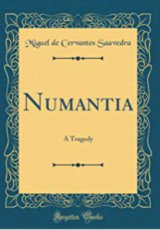The Siege of Numantia
The Siege of Numantia is a tragedy by Miguel de Cervantes set at the siege of Numantia. The play is divided into four acts. The dialogue is sometimes in tercets and sometimes in redondillas, but for the most part in octaves.
"A death with honour is supremest bliss, No fate can be more excellent than this." Act ii. p.27. To the Memory of GENERAL GORDON, THE HERO OF KHARTOUM, THE MODERN PALADIN, OUR CHRISTIAN THEOGENES, WHOSE SUBLIME FAITH, FORTITUDE, AND SELF-SACRIFICE, MATCHLESS IN THESE TIMES, HAVE MADE HIS NAME SACRED IN EVERY HOUSEHOLD, THE TRANSLATOR HUMBLY DEDICATES THIS ENGLISH VERSION OF ONE OF THE SADDEST TRAGEDIES EVER PENNED; WHICH NEVERTHELESS IS INSTINCT WITH THAT TRAGIC PAIN WHICH PURIFIES THE SOUL, AND INCITES TO SUCH DEEDS OF SELF-DEVOTION AS DISTIN- GUISHED THE HERO, WHOSE LOSS BRITAIN MOURNS THIS DAY WITH A PECULIAR SOR- ROW, NOT UNMIXED WITH SHAME. INTRODUCTION. This is an attempt to render for the first time into readable English verse the one great drama of Cervantes. It was presented on the Madrid stage about the year 1586, during the reign of Philip II., and was received with great applause as a work of national interest. It remained, however, unprinted and was supposed to be lost. In 1784, it was published for the first time by Sancha of Madrid, in a volume which contained also Cervantes' Viaje del Parnaso, and his Trato de Argel. The Editors, with a carelessness characteristic of the times, do not tell us how it was recovered or where they got it. The literary world, however, received it gladly as a work of peculiar original power, in every way worthy of the name of Cervantes. Strange to say, a number of years afterwards, it sprang to life as an acting drama during the memorable siege of Saragossa by the French, where it had a besieged city for its stage, and patriots and heroes for its actors and audience. A work that has such a history, and has shown such persistent vitality, must have something in it worthy of the study of all lovers of the Drama, and no apology seems needful for presenting it now in an English version, which preserves the original metres, and pays due regard to accuracy and idiomatic expression. Rightly to estimate such a production we must take into account the period during which it was written and the purpose for which it was invented. Cervantes was at this time about thirty-nine years of age. He returned from his captivity in Algiers in 1580. He was married in 1584, and with the gallantry peculiar to his nature he laid at the feet of his bride the first fruits of his genius, a pastoral romance known as La Galatea. The newly married pair, who lived at Esquivias, a few miles from Madrid, had the slenderest of fortunes, and as love would not fill the cupboard, Cervantes followed his natural inclination, went to Madrid, and took to writing for the stage. Though the pay was scanty it was better than could be got by writing sentimental romances. He remained at this occupation till he left for Seville in 1588, and wrote, as he tells us, between twenty and thirty plays. At this period, throughout Europe generally, dramatic art, and tragic art especially, was still in its infancy, and its laws and principles were as yet undetermined. In Italy Tasso had produced his "Aminta" at Ferrara, and Guarini his "Pastor Fido" at Milan (1585), but Italian Tragedy had yet to await the advent of Maffei, Metastasio, and Alfieri in long after years. In France Corneille and Racine were as yet unborn. In England such authors as Marlowe, Greene, and Peele were beginning their careers, and Shakespeare, a youth of twenty-two (he was seventeen years the junior of Cervantes) was perchance only brooding over his "Venus and Adonis." In Spain such writers as Juan del Encina, Torres del Naharro, Gil de Vicente, and the authors of the famous Tragi-Comedy, Celestina, at the beginning and middle of the sixteenth century, had done good service to Spanish Literature, but had settled nothing as to the form which the Spanish drama should take. Cervantes himself looked upon Lope de Rueda as the true originator of a genuine national theatre. He died in 1565, and was buried between the choirs of the Cathedral of Cordova (that wonderful Moorish Mosque), an unexampled honour in those days. A man of the people himself (he was a gold-beater by trade) he became the idol of the people both as actor and author. His pasos (equivalent to the French proverbes), founded on national manners, and flavoured with true Spanish salt, were unrivalled, and wherever his booth-theatre was pitched, in town or country, he was received with acclamation. Cervantes, during his boyhood, was charmed with him, and the impressions he received were never effaced. But that homespun genius could teach him nothing in the highest walks of his art. When Cervantes, then, began to write for the Tragic stage he had no models before him, and very little critical light to guide him. He was the first genius of commanding power in modern times, whether in Spain or elsewhere, who attempted to compose Tragedies, and he was more or less a law to himself. His Numantia, which German critics declare to be the first work of real tragic power that had appeared in Europe since the extinction of the Greek and Roman drama, has therefore a historical value apart altogether from its artistic merit. The genius of Cervantes was Epic rather than Dramatic, and it is interesting to observe that in this play, almost his first and certainly his greatest effort, he adopts the construction of the earlier Greek drama in its severest form, rejecting, however, the Chorus, which he replaces by allegorical figures serving a similar purpose. In the main he is a follower, consciously or unconsciously, of Aeschylus, in such plays as the Seven against Thebes, or The Persians. Aeschylus (according to Aristophanes) says of his Persians that it was the "taking of a theme for poetry of a glorious exploit (κοσμῆσαι ἔργον ἄριστον)." In like manner the Numantia of Cervantes is simply a glorious page in Spanish history converted into sounding verse. Viewed then as a drama, according to modern ideas, it is manifestly defective. It has neither plot, passion, nor intrigue, and its subject is eminently non-dramatic. The general use, too, of the Ottava rima, with its ceaseless recurring rhymes, is more suited to epic description than to dramatic action. But viewed as an attempt to give form and body on the stage to a great national event, with the intent of inspiring patriotic feelings, its success is undoubted. Though the first act, which presents the motive of the play, drags somewhat, the interest deepens with every scene, and the tremendous catastrophe, with all its attendant accessories of mingled horror, despair, and indomitable resolve, is depicted with a skill, pathos, and concentrated power hitherto unattained. In such a pictorial representation even the despised Octave, supple, sonorous, and monotonous, seems not out of keeping. Each speech is uttered as it were to the beat of the drum, or to the prolonged wailings of the Dead March. When more vigorous description is required Cervantes uses the Terza rima with great effect; and in almost the only bit of action represented (the scaling of the wall by Caius Marius) he employs blank verse with much fitness. If Cervantes had only invented for Spain a dramatic blank verse as fine and effective as that of Shakespeare for England, and had produced therein a series of plays showing such original power as the Numantia, then would the Spanish drama, perhaps, under his guidance have taken a different direction, and reached a higher grade of excellence than it ever attained. But this was not to be. The genius of the Spanish language was against the first effort, and the prevailing taste of the people was equally against the other. The great merit of Cervantes is not that he founded or perfected a national dramatic school. This was reserved for Lope de Vega, who submitted his genius to the taste of the people, and for Calderon de la Barca, who refined and exalted it to the utmost pitch of which it was capable. But this merit he may certainly claim, that he was the first to give a certain form and fulness to what before his time was formless and void. His Numantia, if not a perfect drama and a model for imitation, has an unwonted elevation and grandeur. It is free from that turgid declamation, triviality of incident, and presentation of horrors for horrors' sake, which were the curse of the contemporary tragic plays. For simplicity, directness, and truthfulness of delineation his drama was unique in its own age, and may, in regard to those peculiar qualities, prove of some service even in ours.
Translation
Translate and read this book in other languages:
Select another language:
- - Select -
- 简体中文 (Chinese - Simplified)
- 繁體中文 (Chinese - Traditional)
- Español (Spanish)
- Esperanto (Esperanto)
- 日本語 (Japanese)
- Português (Portuguese)
- Deutsch (German)
- العربية (Arabic)
- Français (French)
- Русский (Russian)
- ಕನ್ನಡ (Kannada)
- 한국어 (Korean)
- עברית (Hebrew)
- Gaeilge (Irish)
- Українська (Ukrainian)
- اردو (Urdu)
- Magyar (Hungarian)
- मानक हिन्दी (Hindi)
- Indonesia (Indonesian)
- Italiano (Italian)
- தமிழ் (Tamil)
- Türkçe (Turkish)
- తెలుగు (Telugu)
- ภาษาไทย (Thai)
- Tiếng Việt (Vietnamese)
- Čeština (Czech)
- Polski (Polish)
- Bahasa Indonesia (Indonesian)
- Românește (Romanian)
- Nederlands (Dutch)
- Ελληνικά (Greek)
- Latinum (Latin)
- Svenska (Swedish)
- Dansk (Danish)
- Suomi (Finnish)
- فارسی (Persian)
- ייִדיש (Yiddish)
- հայերեն (Armenian)
- Norsk (Norwegian)
- English (English)
Citation
Use the citation below to add this book to your bibliography:
Style:MLAChicagoAPA
"The Siege of Numantia Books." Literature.com. STANDS4 LLC, 2025. Web. 20 Jan. 2025. <https://www.literature.com/book/the_siege_of_numantia_60>.




Discuss this The Siege of Numantia book with the community:
Report Comment
We're doing our best to make sure our content is useful, accurate and safe.
If by any chance you spot an inappropriate comment while navigating through our website please use this form to let us know, and we'll take care of it shortly.
Attachment
You need to be logged in to favorite.
Log In